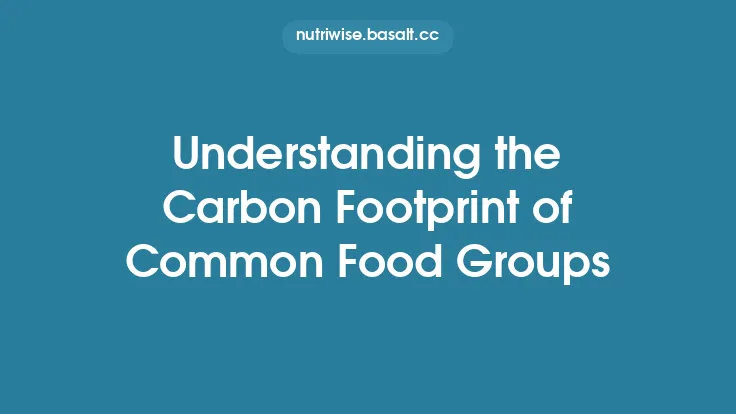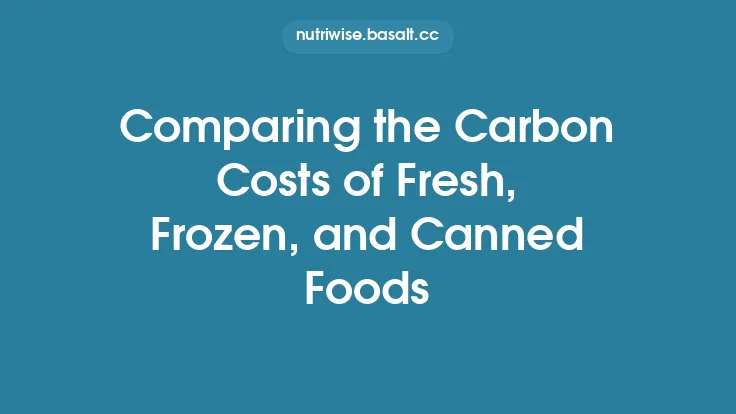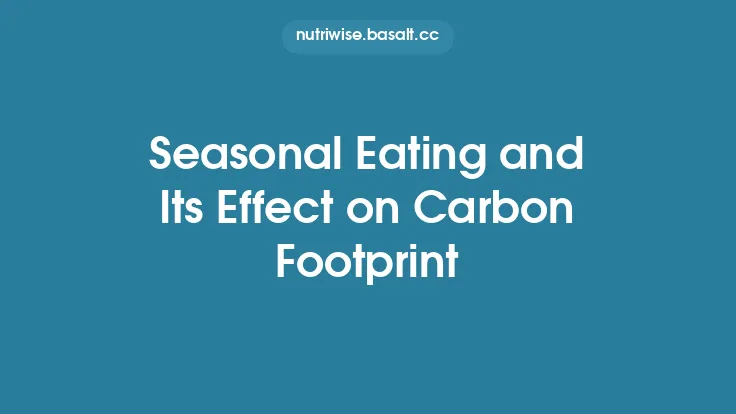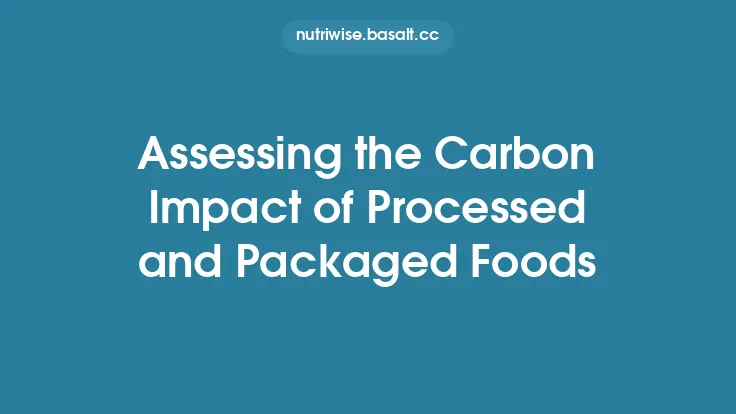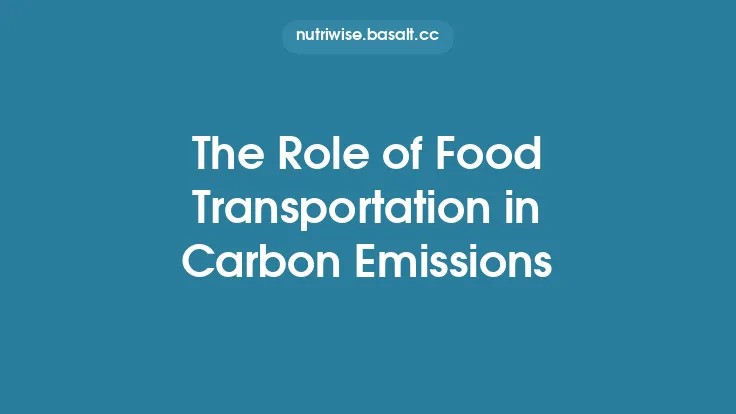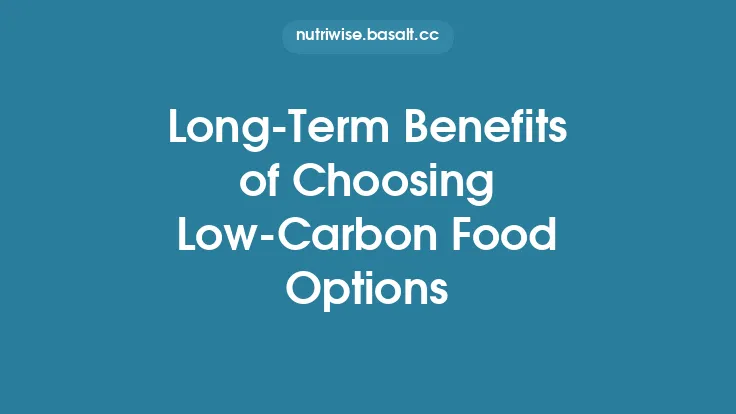Home‑grown produce often conjures images of backyard tomatoes, balcony herbs, and the satisfaction of harvesting food you have tended yourself. While the emotional and nutritional benefits are well‑known, the environmental impact—particularly the carbon footprint—of growing your own vegetables and fruits can be surprisingly complex. In this article we break down the key factors that determine the greenhouse‑gas (GHG) emissions of home‑grown versus store‑bought produce, compare typical emission ranges, and explore practical ways to tip the balance in favor of lower‑carbon food choices.
1. Defining the Carbon Footprint of Food
The carbon footprint of a food item is expressed as kilograms of carbon dioxide equivalent (kg CO₂e) per kilogram of edible product. It aggregates all GHG emissions generated throughout the product’s life cycle, from the extraction of raw materials to the point of consumption. For produce, the main life‑cycle stages are:
| Stage | Typical Emission Sources |
|---|---|
| Agricultural production | Soil preparation, irrigation, fertilizers, pesticides, on‑farm energy (diesel, electricity) |
| Processing & packaging | Washing, cutting, sorting, packaging materials (plastic, cardboard) |
| Transportation & distribution | Truck, rail, ship, air freight, refrigerated transport |
| Retail & storage | Supermarket refrigeration, lighting, waste handling |
| Consumer‑level handling | Home refrigeration, washing, waste disposal |
When evaluating home‑grown versus store‑bought produce, the first two stages (production and processing) dominate for home growers, while the latter three stages add significant emissions for store‑bought items.
2. Emission Drivers in Home‑Grown Produce
2.1 Land Use and Soil Carbon
- Soil carbon sequestration: Healthy, undisturbed soils can store carbon in organic matter. Small‑scale gardens that employ no‑till or minimal tillage, cover crops, and compost can actually act as carbon sinks, offsetting a portion of the emissions from inputs.
- Land conversion: If a garden replaces previously uncultivated land (e.g., a lawn), the net carbon impact may be neutral or even positive, because the new vegetation adds biomass and improves soil carbon.
2.2 Fertilizers and Amendments
- Synthetic nitrogen fertilizers are among the most carbon‑intensive inputs, with production emissions of ~6–8 kg CO₂e per kg of N. Applying them in excess also leads to nitrous oxide (N₂O) emissions from the soil, a potent GHG (≈298 times CO₂ over a 100‑year horizon).
- Organic amendments (compost, manure) have lower embodied emissions, especially when the material is sourced locally or produced on‑site. However, composting still requires energy for turning and may emit methane if anaerobic.
2.3 Water Use and Energy for Irrigation
- Pumped irrigation consumes electricity or diesel. In regions where the electricity grid is carbon‑intensive, irrigation can become a major emission source. Efficient practices—drip irrigation, rainwater harvesting, mulching—dramatically reduce this component.
2.4 Pest Management
- Synthetic pesticides have embodied emissions from manufacturing and can lead to indirect emissions through soil health degradation. Integrated pest management (IPM) and biological controls lower these impacts.
2.5 Infrastructure and Energy
- Greenhouses: Heated or climate‑controlled structures can have high energy demands. A well‑insulated greenhouse powered by renewable electricity may still emit 0.5–2 kg CO₂e kg⁻¹ of produce, depending on climate and crop.
- Indoor grow lights: LED lighting for year‑round production can add 1–3 kg CO₂e kg⁻¹, again heavily dependent on the electricity source.
2.6 Scale Effects
- Small backyard plots often have higher per‑kilogram emissions than larger community farms because fixed inputs (e.g., a compost bin, irrigation system) are spread over fewer kilograms of produce. However, the absolute emissions remain modest compared with industrial supply chains.
3. Emission Drivers in Store‑Bought Produce
3.1 Large‑Scale Agricultural Production
Industrial farms benefit from economies of scale, using precision agriculture, optimized fertilizer application, and mechanized harvesting. This can lower the per‑kilogram emissions of the primary production stage to roughly 0.1–0.5 kg CO₂e kg⁻¹ for many vegetables, though high‑input crops (e.g., tomatoes grown in heated greenhouses) can exceed 1 kg CO₂e kg⁻¹.
3.2 Processing and Packaging
- Washing and sorting: Energy for water heating and machinery adds ~0.02–0.05 kg CO₂e kg⁻¹.
- Packaging: Plastic clamshells, cardboard boxes, and shrink wrap contribute 0.01–0.04 kg CO₂e kg⁻¹, depending on material and recyclability.
3.3 Distribution Network
Even though the neighboring article focuses on transportation, it is unavoidable to acknowledge that moving produce from farm to retailer adds 0.05–0.2 kg CO₂e kg⁻¹ on average. Refrigerated trucks and long‑haul rail increase this figure, while locally sourced items can keep it below 0.05 kg CO₂e kg⁻¹.
3.4 Retail Storage
Supermarket refrigeration and lighting typically contribute 0.02–0.06 kg CO₂e kg⁻¹ over the product’s shelf life. Energy‑efficient stores with renewable electricity can reduce this substantially.
3.5 Food Waste
Retail and consumer waste adds indirect emissions. Unsold produce that ends up in landfill generates methane during decomposition, equivalent to ~0.5 kg CO₂e per kilogram of wasted fruit or veg. While this is a downstream factor, it influences the overall carbon profile of store‑bought items.
4. Comparative Emission Ranges: Home‑Grown vs. Store‑Bought
Below is a synthesis of peer‑reviewed life‑cycle assessment (LCA) data for common produce items. Values are presented as typical ranges for home‑grown (small‑scale, conventional inputs) and store‑bought (average supermarket supply chain) per kilogram of edible product.
| Produce | Home‑grown (kg CO₂e kg⁻¹) | Store‑bought (kg CO₂e kg⁻¹) | Key Drivers |
|---|---|---|---|
| Tomatoes (field‑grown) | 0.3–0.7 | 0.8–1.5 | Fertilizer use, irrigation vs. greenhouse heating for store‑bought |
| Tomatoes (greenhouse) | 1.0–2.5 | 1.2–2.0 | Energy for heating & lighting (home) vs. industrial greenhouse |
| Lettuce | 0.2–0.5 | 0.4–0.9 | Minimal inputs at home; packaging & refrigeration for store |
| Carrots | 0.15–0.35 | 0.3–0.6 | Soil preparation and compost (home); transport distance (store) |
| Apples (tree fruit) | 0.25–0.5 | 0.4–0.8 | Long‑term carbon sequestration in orchard soils (home) |
| Strawberries | 0.8–1.5 | 1.2–2.2 | High labor and fertilizer (home); refrigerated transport (store) |
Interpretation
- For low‑input, open‑field crops (lettuce, carrots, apples), home‑grown produce typically has a 30–50 % lower carbon footprint than the average store‑bought counterpart.
- For high‑input or greenhouse‑grown crops (tomatoes, strawberries), the advantage narrows. If a home gardener relies on synthetic fertilizers, heated greenhouses, or high‑energy LED lighting, the emissions can equal or exceed those of commercially produced items.
- The largest variability stems from the gardener’s practices (organic vs. synthetic inputs, water source, energy mix) and the distance the store‑bought product travels.
5. Methodology for Estimating Your Own Carbon Footprint
If you want to quantify the emissions of a specific home garden, follow these steps:
- Inventory Inputs
- Record quantities of fertilizers (N‑P‑K), compost, pesticides, and seeds.
- Note energy use: electricity (kWh) for pumps, lights, greenhouse heating; diesel (L) for equipment.
- Assign Emission Factors
- Use reputable databases (e.g., IPCC 2022 GHG Inventory, Ecoinvent). Example factors:
- Synthetic N fertilizer: 6.5 kg CO₂e kg⁻¹ N
- Compost (locally produced): 0.2 kg CO₂e kg⁻¹
- Electricity (grid average, U.S.): 0.45 kg CO₂e kWh⁻¹ (adjust for local mix)
- Diesel: 2.68 kg CO₂e L⁻¹
- Calculate Production Emissions
\[
\text{Emissions}_{\text{prod}} = \sum (\text{Input amount} \times \text{Emission factor})
\]
- Account for Soil Carbon Change
- Estimate net soil carbon sequestration using the Carbon Farming Index or similar tools. A modest increase of 0.1 t C ha⁻¹ yr⁻¹ translates to a negative 0.37 kg CO₂e m⁻² yr⁻¹, which can be prorated to your garden area.
- Divide by Yield
- Measure the total edible weight harvested (kg).
- \[
\text{Carbon footprint (kg CO₂e kg⁻¹)} = \frac{\text{Emissions}_{\text{prod}} - \text{Soil sequestration}}{\text{Yield}}
\]
- Compare to Benchmarks
- Use the ranges in the table above or published LCA datasets for the same crop to see where you stand.
6. Strategies to Reduce the Carbon Footprint of Home‑Grown Produce
| Strategy | How It Lowers Emissions | Practical Tips |
|---|---|---|
| Adopt organic soil amendments | Cuts embodied emissions of synthetic fertilizers; improves soil carbon | Compost kitchen scraps, use leaf mold, apply manure from local farms |
| Implement water‑saving irrigation | Reduces electricity/diesel for pumping | Drip lines, rain barrels, mulching to retain moisture |
| Choose low‑energy growing methods | Avoids heating and lighting in temperate climates | Grow seasonally, use cold frames instead of heated greenhouses |
| Utilize renewable energy | Offsets electricity used for pumps, lights | Install solar panels on a shed roof, purchase green electricity |
| Practice crop rotation and cover cropping | Enhances soil health, reduces need for external inputs | Rotate legumes with heavy feeders, sow winter rye as cover |
| Minimize packaging and transport | Eliminates downstream emissions | Harvest directly to reusable containers; share produce with neighbors to avoid trips |
| Select high‑yield, low‑input varieties | More food per unit of input | Choose heirloom or hybrid varieties bred for local conditions |
| Integrate pest management | Lowers pesticide production emissions | Encourage beneficial insects, use row covers, hand‑pick pests |
By combining several of these measures, a backyard gardener can often achieve a net-negative carbon footprint for certain crops, meaning the garden sequesters more carbon than it emits.
7. When Store‑Bought Produce May Be the Lower‑Carbon Choice
It is not always the case that home‑grown produce is greener. Situations where store‑bought items can have a smaller carbon footprint include:
- High‑energy indoor farming: If a gardener relies on continuous LED lighting and climate control, especially powered by a fossil‑fuel‑heavy grid, emissions can surpass those of a large, efficiently managed commercial greenhouse.
- Very small yields: A garden that produces only a few kilograms per season but consumes the same amount of water, fertilizer, and energy as a larger plot will have a higher per‑kilogram footprint.
- Locally sourced, seasonally appropriate store items: When supermarkets stock produce grown within a 50‑km radius and sold without extensive refrigeration, the transportation and packaging overhead can be minimal, making the overall footprint comparable to a modest home garden.
In such cases, the most carbon‑efficient decision may be to purchase the store‑bought version while still supporting local producers.
8. The Bigger Picture: Integrating Home Gardening into Sustainable Food Systems
Home gardening should be viewed as one component of a broader low‑carbon food system. When combined with other practices—such as reducing food waste, choosing plant‑based meals, and supporting community‑scale farms—the cumulative impact can be substantial. Even if a single garden’s emissions are modest, the collective effect of thousands of households growing food can:
- Increase urban green space, improving microclimates and reducing the urban heat island effect.
- Enhance biodiversity by providing habitats for pollinators and beneficial insects.
- Strengthen food security, reducing reliance on long supply chains.
Thus, while the carbon calculus is essential, the ancillary environmental and social benefits further justify the promotion of home‑grown produce.
9. Quick Reference Cheat Sheet
| Aspect | Home‑grown (low‑input) | Store‑bought (average) |
|---|---|---|
| Typical carbon footprint | 0.2–0.7 kg CO₂e kg⁻¹ | 0.4–1.5 kg CO₂e kg⁻¹ |
| Major emission sources | Fertilizer, water pumping, energy for greenhouse (if used) | Processing, packaging, transport, retail refrigeration |
| Potential carbon sink | Soil carbon sequestration (0.1–0.3 kg CO₂e kg⁻¹) | Minimal (often net source) |
| Key mitigation levers | Compost, rainwater, renewable energy, crop rotation | Choose local, minimally packaged, seasonally appropriate items |
| When store‑bought may win | High‑energy indoor grow, very low yields | Efficient large‑scale production, short transport distance |
10. Concluding Thoughts
The carbon footprint of produce is not a binary “home‑grown = good, store‑bought = bad” equation. It hinges on how each system operates. By carefully managing inputs, optimizing water and energy use, and leveraging the natural carbon‑sequestering capacity of soil, home gardeners can often achieve a lower‑carbon product than the average supermarket offering. Conversely, when home production relies on energy‑intensive infrastructure or yields are minimal, the commercial supply chain—especially when it sources locally and minimizes packaging—may be the greener option.
Ultimately, the most sustainable path lies in informed choices: grow what you can efficiently, support local producers for what you cannot, and continuously refine practices to push the carbon balance further into the negative. In doing so, every garden, balcony, or community plot becomes a small but meaningful node in the global effort to reduce food‑related greenhouse‑gas emissions.
